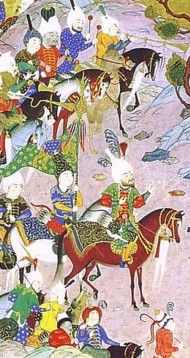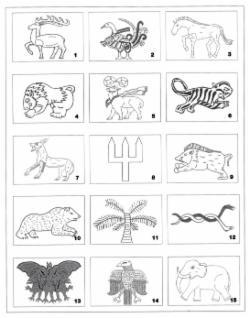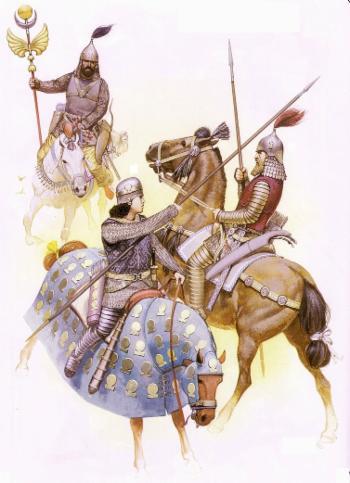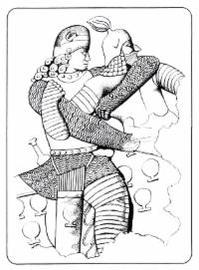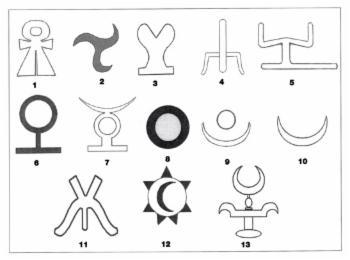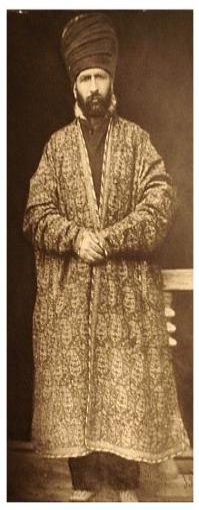| The Heroic and Historic Era The Kurdish Era The Qajar Era The Pahlawi Era | The Zarrinkafsch-Bahman (Qajar) Family |
The
pedigree of our paternal ancestors goes back to Old Iranian
mythological roots from the dark ages before the time of history
tracing back to famous hero Tus-Nowzar, one of the great Iranian warriors and last Zoroastrian Immortals of the Holy Script Avesta. Tus was a royal prince born to the House of Nowzar, and King Nowzar (Mid. Naudhar, Avest. Naotara) was the son and successor of the Great-King Manoutchehr, the fifth king of the legendary Pishdadian-Dynasty.
In his legendary half-narrative half-historical epic Shahnameh ("Book
of the Kings") Ferdowsi told us about the deeds of Prince Tus-Nowzar: Tus was a wise and brave man but also proud and pugnacious. And because
of these characteristics Tus and his brother Gustaham were not chosen
by the nobles as heir to their father King Nowzar. The divine
glory (Mid. khvarrah, Pers. farr)
was not come upon them. But instead their cousin Zab became the new
king of Iran and founder of the famous Kayanid-Dynasty. Nevertheless
Tus was a loyal vassal to the following kings Kay Kavadh (Kay Qobad)
and Kay Kavus and a great warrior defending Iran against her old
arch-rival Turan, the land of the Turanians. Among the first and
noblest knights he accompanied the king, lived at court and his device
showed a golden elephant as well as he and his kin wore golden shoes.
There is a passage in Ferdowsi's Shahnameh in the tale about Rostam and Sohrab when Sohrab asked Hojir about the Iranian Pahlavans and their signs.
Sohrab asked: "On the right side one can see many esquerians and elephants and luggage. A black pavillon is errected there and around it there are many troops and tents. Elephants and horses stand in front of the tents. And in front of the pavillion there is a flag depicting the sign of an elephant. At the entrance you see esquerians with golden shoes." And Hojir answered: "This man is Tus, Nowzar's son, because his flag bears the sign of an elephant."
Sohrab asked: "On the right side one can see many esquerians and elephants and luggage. A black pavillon is errected there and around it there are many troops and tents. Elephants and horses stand in front of the tents. And in front of the pavillion there is a flag depicting the sign of an elephant. At the entrance you see esquerians with golden shoes." And Hojir answered: "This man is Tus, Nowzar's son, because his flag bears the sign of an elephant."
But
finally when Kay Kavus had chosen his grandson Kay Khusrow as heir to
the throne of Iran, Tus rebelled, and again declared his claims as the
oldest son of Nowzar, because the young pretender had a Turanian mother
and thus, Turan’s blood line would come to power in Iran, at least. In Tus' opinion the House of Kay Kavadh
lost it's right of power and Tus did not run all of the king’s orders correctly anymore. And a civil war about succession broke out between the House
of Tus and the House of Godarz. And a lot of brave men on both sides were killed in several
battles of this war. Godarz was another heroic warrior of
Iran, a loyal vassal to the king’s wishes and a supporter of Kay
Khusrow. He also was one of the most popular warriors of Iran and very familiar
with the common people. But Prince Tus as the eldest son of the former King Nowzar
was the noblest hero and therefore by blood the right pretender to the
throne. And when Tus attacked Farud, Kay Khusrow’s
half-brother and commander of the Turanian fortress of Kalat, vice
versa Farud killed Tus’ son-in-law Rivniz and Tus’ own son Zarasp,
who was married with one of Rivniz forty sisters and hence nearly
terminated the line of Nowzar completely. And then Farud himself was
killed by Tus in a combat after a lot of Iranian warriors must have
died.
Thus,
to end the long bloody war of succession in Iran the old king Kay Kavus
decided to make an assessment between the claimant to the throne Tus,
and his own heir Kay Khusrow, to challenge who would be fit and
qualified for throne and crown of Iran. And the test said, that he who
could enter the magic dragon guarded Bahman Fort would become the
future king. Tus tried it first but he failed. And when Kay Khusrow
came to the fort, he rose a banner with God's name and suddenly a hidden gate occurred and he could enter
it. That was an indicator for Kay Khusrow’s divine glory and his
purpose to become the next rightful king. Tus accepted the result and
paid obedience to the new designed king. And for his service and
loyalty he was granted the greatest honours as a royal prince.
And after that Kay Khusrow marched with a huge army against Iran’s old enemy Turan and Tus was the commander-in-chief. But also Tus was still proud and confident and thus, again made a lot of mistakes on his way. In every single battle against Turan the Iranian army only lost, and in secret Tus was not content with the new king and not in line with his way to rule Iran, hoping to secure the crown for his own house. And during the recent battles it was obvious, that Tus did not held any discipline among his troops, and so the Turanians could manage to overthrow the Iranian army, when the latter were at a carousal celebrating their alleged invincibility. And therefore, Tus was disgraced and arrested by Kay Khusrow. But by time he became clarified and finally saw his faults and he regretted his former arrogance and he regained the king’s favour and at the end he led the Iranian army finally into victory against Turan.
And after that Kay Khusrow marched with a huge army against Iran’s old enemy Turan and Tus was the commander-in-chief. But also Tus was still proud and confident and thus, again made a lot of mistakes on his way. In every single battle against Turan the Iranian army only lost, and in secret Tus was not content with the new king and not in line with his way to rule Iran, hoping to secure the crown for his own house. And during the recent battles it was obvious, that Tus did not held any discipline among his troops, and so the Turanians could manage to overthrow the Iranian army, when the latter were at a carousal celebrating their alleged invincibility. And therefore, Tus was disgraced and arrested by Kay Khusrow. But by time he became clarified and finally saw his faults and he regretted his former arrogance and he regained the king’s favour and at the end he led the Iranian army finally into victory against Turan.
And
Tus lived 900 years, and founded the city of Tus in the province of
Khorassan next to today’s city of Mashhad. (It is said that the city of
Tus was the capital of Parthia and the residence of King Vishtasp.)
And in several adventures he protected Iran and her ruler Kay Khusrow
against demons and dragons. And after that, one day in wintertime the
court arranged a shoot in the woods, and also Tus was among Kay
Khusrow’s companions who rode into wilderness and suddenly disappeared
completely behind the fallen snow. And it is said that at the end of
times, at Judgement Day he will occur again as one of the thirty
Immortals, to fight at the side of the Holy Saviour for Good, and in
the final apocalyptical battle he will destroy all creatures of Evil!
Crests of the Iranian warriors: 1. Ahug (deer), 2. Tardarw (bird), 3.
Asp (horse) for the House of Zangeh, 4. Shaigr (lion) for the House of
Godarz, 5. Warran (ram) for the House of Bahram, 6. Babr (tiger) for
the House of Shidush, 7. Gorg (wolf) for the House of Gev, 8. Thritha
Zardusht (trident), 9. Baraz (boar) for the House of Goraz, 10. Khirs
(bear), 11. Draxt (tree), 12. Garzag (snakes), 13. Haftan-bokht
(dragon) for the House of Rostam, 14. Humay (phoenix), 15. Pil
(elephant) for the House of Tus. (Source: Dr. Kaveh Farrokh, p. 21.)
The legend further says that eleven mythological offspring followed their progenitor Tus. Their names were Yawar, Kardank, Tiruyeh, Aubid (Avid), Karvan, Karen (Qaren), Veshapur I, Nersi, Zahan, Veshapur II and Sokhra.
Ehsan
Yarshater mentioned that the historical pendant to the mythological
House of Tus could be found in a branch of the Parthian Arsacid Dynasty (247
BC to 224 AD), and the dispute between the royal heroes Tus and Godarz may reflect a
rivalry between two powerful Parthian noble houses. Such a war of
succession happened when different lines of the Arsacides (Ashkanian)
struggled for becoming Great King of the Parthian Empire which was only
known by later Persian historians as a kingdom of 18 "petty rulers"
(Mid. kadak-khwaday, Arab. moluk al-tawa'ef).
Therefore, the figure of Godarz can be identified as
the historic “Satrap of Satraps” Gotarzes son of Gev, who occupied the
Parthian throne as rival-king (r. 40 and 45-51), when adopted as son by
Artabanos II (r. 10-40) and ruled after him and his native son Vardanes
I (r. 40-45). Gotarzes' own rule was attacked by another Arsacid
rival-king called Meherdates (r. 49-50), the son of Vonones I (r. 8-11)
and grandson of Phraates IV (r. 37-2 BC) – but this prince failed at
the end.
In the same way, the House of Tus finds its role model in a branch of the Parthian noble house of Karen,
since in both families the very same names and persons appeared up from Karen, son of Karvan.
The House of Karen (also Karen-Pahlavi) were an aristocratic feudal family of Hyrcania (Mid. Verkana, Pers. Gorgan,
which means lit. “Land of the Wolves”), a satrapy situated on the
southern shores of the Caspian Sea. The seat of the house lay at Mah
Nihawand, about 65 km south of Ecbatana (Hamadan) in the province of
Media. The Karenas claimed descent from Karen (Arab. Qaren), a figure of folklore and son of the equally mythical Kaveh the Blacksmith. It is said that Karen became commander of King Manoutchehr, and during the reign of Nowzar fought against the Turanians. When Barman, the
son of Visa, one of the Turanian heroes, killed the aged Kavadh, Karen
in revenge killed Barman. Finally Karen was one of the seven petty
rulers instituted by King Vishtasp (Kay Goshtasp - the father of the historical Darius the Great) in Mah Nihawand.
Indeed, the House of Karen is first attested in the Arsacid era, specifically as one of the so-called Seven Parthian Clans or “Seven Houses” (haft khandan), feudal
families affiliated with the Parthian and later Sassanian court. These
seven houses were the House of Aspahapet or Spandiyar of Apartvaticene
(Yazd), the House of Dhahae or Zik of Astabene (Kushan), the House of
Karen of Hyrcania (Gorgan), the House of Mehran of Comisene (Semnan),
the House of Parni or Nahabad of Parthyene (Parthia), the House of
Sohae or Spahbad of Margiane (Merv), and the House of Suren of Sakestan
(Sistan). They held important posts in military and administration and became provincial sub-rulers or satraps (Mid. khashtraban, Pers. shahrbed) of Iranian territories. Only
two of the seven - the House of Suren and the House of Karen - are
actually attested in relevant sources dateable to the Arsacid period.
They were similar in dignity and the most noble and oldest feudal
houses. The remaining five families emerged not until Sassanid times
and their genealogies only were extended to the Parthians in order to
emphasize the antiquity of their families. The members of the Karen clan
mostly are only known by their hereditary title of Karen (Qaren), not
by their given names. And according to historians the Karenas descended from the Arsacid royal stock, to be more precise from Arshavir, better known as Great King Phraates IV. The first one, known under this name was Arshavir’s son Karen-Pahlav (Arab. Qaren al-falhawi),
meaning literally “Karen the Parthian”. He was commander under the already mentioned Arsacid King Meherdates and prevailed by Gotarzes in 50
AD.
His special rivalry with Gotarzes is also an indicator to identify the Parthian Karenas with the House of Tus and their dispute with Godarz. However,
the two centuries following his time were the period in which the older
Iranian myths became transformed into a chivalresque epic in which many
historical figures were introduced into the older form of the legend,
among them the historical Karen indentified as Karen son of Karvan from the House of Tus.
When the Persian Sassanid Ardashir I (r. 224- 240) established himself as “King of Kings” (shah-an-shah) meaning emperor of Iran after killing the last Parthian Artabanos IV (r. 213-224) in the Battle of Hormizdagan, the seven purportedly “Parthian” feudal aristocracies including the Karenas allied with the new founded Sassanian Dynasty (224 to 651 AD). While the clan of Suren were "arch-marshalls" responsible for the army commando, under the Sassanians the Karenas were the “arch-treasurers” in charge of the empire’s finances, and their most popular members were:
Peroz Karen-Pahlav, who was their clan's head, strategos or satrap of Shiraz and envoy of Ardashir I to Artabanos IV.
Ardakhshir Karen-Pahlav, who was a companion of Narseh (r. 293-302).
Ardawan Karen-Pahlav, who was the army commander (spahbedh) of Shapur II (r. 309-379) and conquered vast territories in Iran’s north for the Sassanids.
Karen son of Goshtasp Karen-Pahlav, who lived during the time of Yazdgerd I (r. 399-420).
Parsi Karen-Pahlav son of Borzmehr, who lived under Bahram V Gur (r. 420-438).
One other member of the famous House of Karen was Sokhra Zarmehr, our own very immediate ancestor! Sokhra was the son of Veshapur, scion of Karen son of Karvan (Qaren al-falhawi), and therefore a descendent of the House of Tus-Nowzar. Born in Shiraz, where his family resided, he became “margrave” (marzban) of Sakestan. During the reign of Peroz (r. 459-484), Sokhra was army commander defeating the Armenians headed by Vahan in 483, and then became sometimes regent of the empire (vuzurg-framandar).
After Peroz’ death in 484 AD he took residence in the northern parts of
the Sassanid Empire and instituted Balash (r. 484-488) as the royal
successor. Under him and his successor Kavadh (r. 488-496 and 498-531),
whom he had released from prison, Sokhra Zarmehr was
vicegerent of Kabul, Ghazna and Zabul, and then head of political
affairs, but finally when becoming too powerful, he was betrayed by King Kavadh, overthrown and handed out to his opponent Shapur Mehran-Pahlav, who killed him on behalf of the king. Sokhra Zarmehr had two sons: Zarmehr (Borzmehr) and Qaren.
Zarmehr
reinstated Kavadh in 598, and he and his brother fought in the battle
against the White Huns (Hephthalites) and supported and aided Khusrow
I. Anushiravan (r. 531-579). For their loyalty Khusrow gave Zarmehr the
fief of Zabulestan and the rulership over Gilan (r. 537-558), where his
line reigned as Persian vicegerents until 687 AD. His brother Qaren got the area of Jebel al-Qaren or Koh-e Qaren (“Mount of Qaren”) in Mazanderan and in 565 AD was made Espehbedh
(hereditary governor) of Tabaristan (r. 565-602), where his line ruled
as Qarenid Dynasty until the end of the ninth century. The second Sokhra (Arab. Sufrai) son of Qaren son of Sokhra
was instituted by Khusrow I in 572 as governor of Tabaristan. Qaren son
of the Qarens (Qaren ben Qarinas al-Qarnas) held the troop command
under Ardashir III (r. 628-629), but in 637 he fled from the battle of
Qadessiyah and was defeated by the Arab Ibn Amir at Hamadan. During the Arab invasion the
Karenas tried to maintain semi-independence by paying tribute to the
Caliphate, and some of the lands of the Karenas appear to have remained
independent until the 11th century, after which the House of Karen is
no longer attested.
In ancient times Sassanid society was divided into the four classes of Priests (atorbanan), Warriors (arteshtaran), Scribes (dabiran), and Peasants (vasteryoshan).
The nobility was a mixture of old Parthian clans, Persian aristocratic
families, and noble families from subjected territories, and was
divided into local kings (shahrdaran), royal princes (vaspuhragan), the heads of the great clans (vuzurgan), and the other noble freemen (azadan), headed by their Sassanid overlord, the emperor.
Traditional symbols of these aristocrats were tiara, golden ear rings
and golden belt – often decorated with their heraldic emblems on their
armour and banners. In addition to that the mounted generals (savaran) of the Sassanid army also wore golden shoes as symbol of their royal status and to distinguish from ordinary soldiers.
One of these brave royal commanders from Sokhra’s line of the Karenas was
Gustaham ben Ashak-e Zarrinkafsh
(Gustaham son of Arsaces the Gold Shoe, i.e. “from the royal stock”).
In the Dastan-e Amir Hamza p. 231 the story about this general is told when Emperor Khusrow Anoushiravan planned to defeat the rebellious Bahram Gur and ordered his wise vizier Buzurjmehr to send a military campaign:
''Naushervan said: I authorize you to appoint whomever you find worthy of leading this campaign and crushing this recreant! Buzurjmehr chose Gustham
ben Ashk-e Zarrin Kafsh, a renowned Sassanid commander, eminent in that assembly of warriors, and had the Emperor confer upon him a robe of honor. He was sent at the head of twelve thousand fierce and sanguine troops, with a retinue of very many valiant lords and ferocious and lionhearted veterans, for the correction and chastisement of Bahram Gur, the Emperor of China, with strict orders to exact also from Bahram Gur an offering in the way of a fine, in addition to the four years’ tribute due in arrears, and in the event of the least show of resistance, to inflict a humiliating defeat upon him, and bring him to Ctesiphon chained and fettered. Gustham was sternly enjoined not to depart from or mitigate those commands, and on receiving his orders, he made obediance and left for China."
Following the total defeat of the Sassanians by the Muslim Arabs at the
Battle of Nihawand 642 AD and the conquest of the north-western part of
the Persian province of Media with today’s Kurdistan, his family
pledged allegiance to the Caliphate and could still secure some of
their domains. Under the Arabs his line was called "Zarrinkafsh ben Naudharan" and he became the founder and eponym of our family!
Sassanid badges (tamga): 1. House of Sassan, 2. Military unit, 3. House of Karen, 4-5. Persian aristocracies, 6. Artabanos, 7. Shapur, 8. Sun emblem (khwar), 9. House of Suren, 10. Crescent emblem, 11. Hormizd, 12. House of Mehran, 13. Shapur I. (Dr. Kaveh Farrokh, p. 23.)
To continue to The Kurdish Era - click here
This website was created by Arian K. Zarrinkafsch (Bahman-Qajar).

